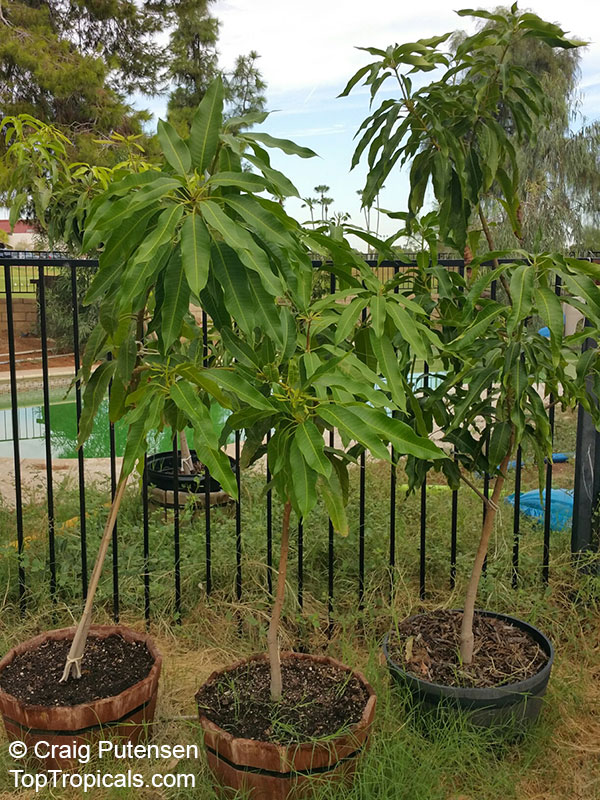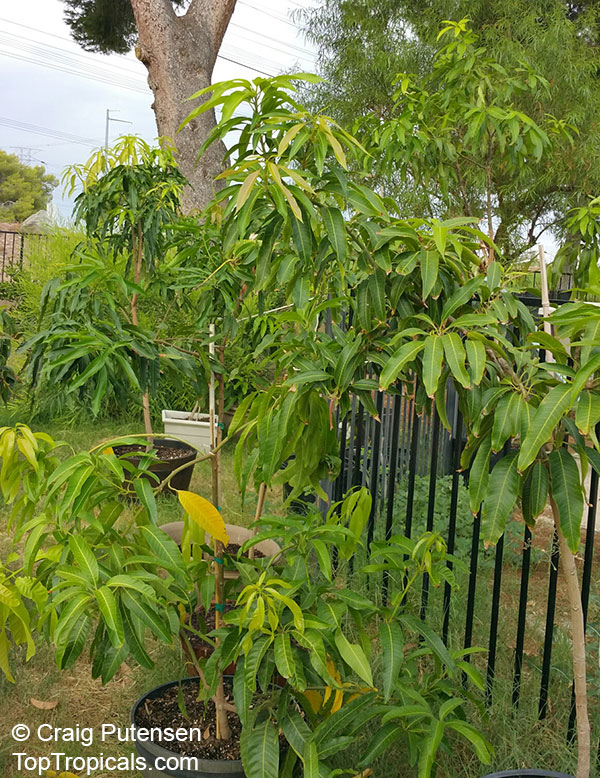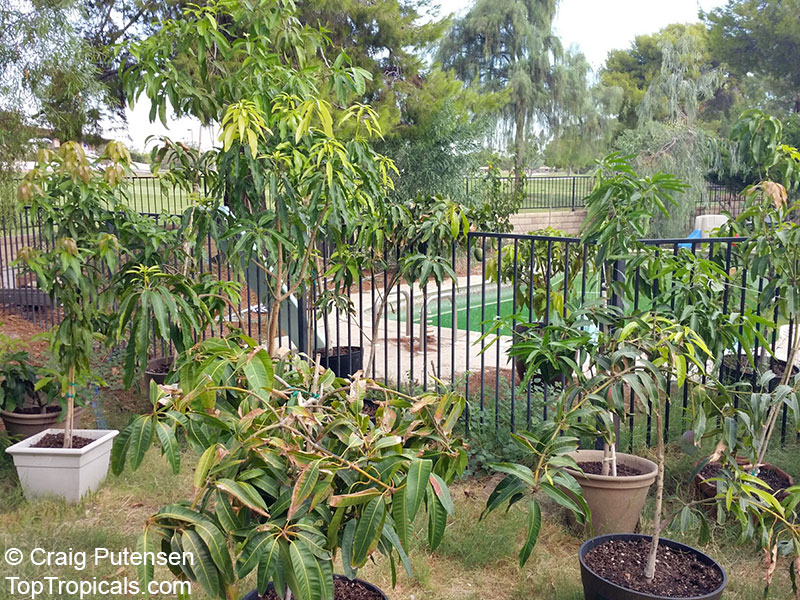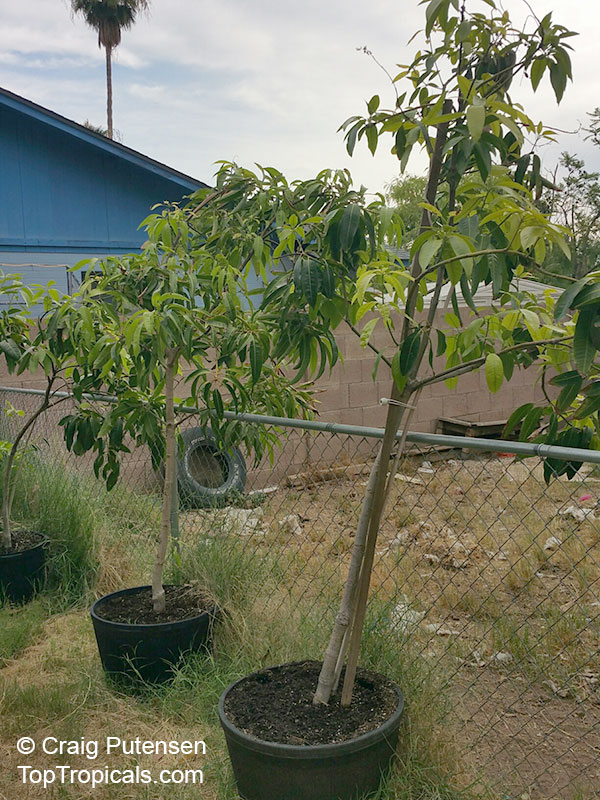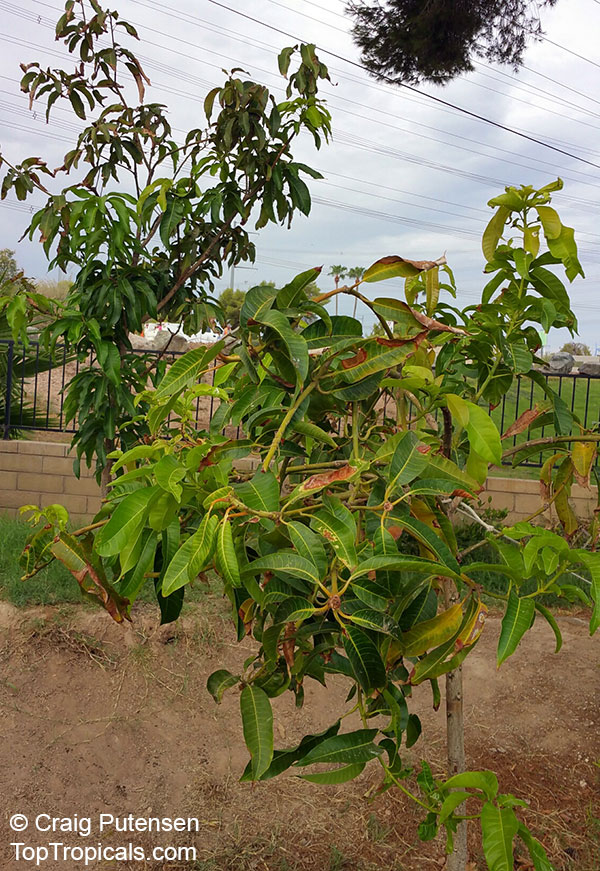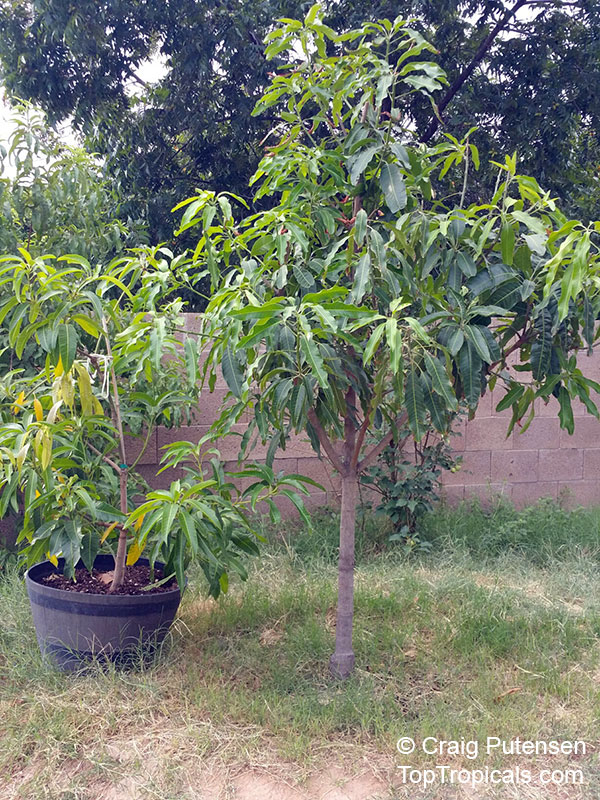How to container grow Mango trees in Arizona
by Craig Putensen
click on image to enlarge
Coconut cream and Edward
Po Pyu Kalay and Pineapple pleasure
Mango tree is pretty easy to adapt to a hot and dry climate. Even hot Arizona can offer a suitable environment for it, as long as the plant is in loving hands of a patient gardener.Craig Putensen lives in Tempe, AZ. He has been our loyal customer for several years, purchasing different kinds of mango trees from Top Tropicals. He is sharing his experience with us how to grow a mango tree in Arizona. With hot and dry summers, chilly winters, and pretty "difficult" soils, what is the secret of success? After looking at his healthy trees, one must admit that Craig sure has his know-how! Below are his growing tips in a nutshell.
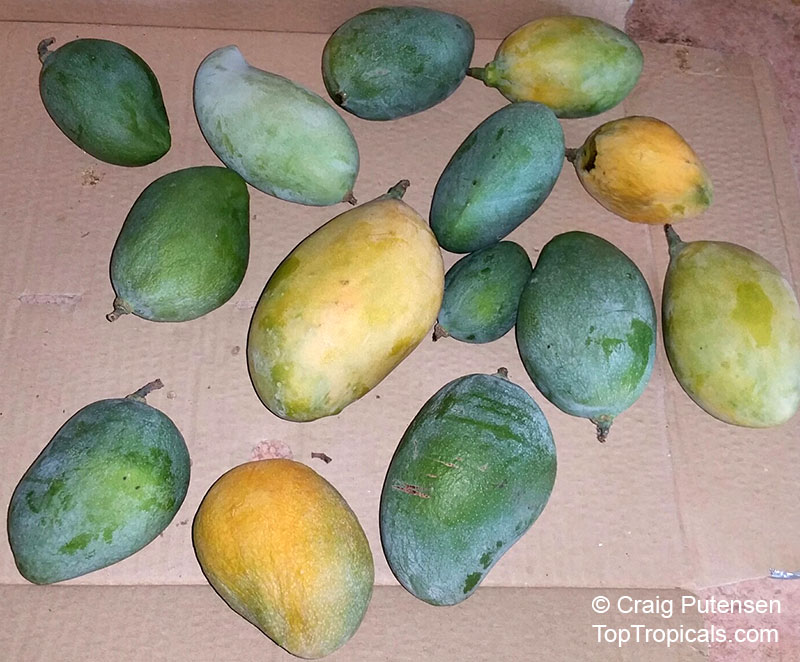
Soil: Mix equal parts of crushed lava rock, pine bark fines, coco choir, and sand to fill your container. A more simple method is to purchase a cactus soil mix from local big box stores works well too, but does not last as long, dries fast in summer and will need to be topped off periodically. When planting the mango tree in the container be sure to leave 2 to 3 inches at the top of the container and add thick layer of mulch.
Container: Choose a pot shape consistent with the shape of a ½ whiskey barrel, in a size that is appropriate for the size of your mango tree root ball. Containers that can breathe such as wood and clay are preferred, but are much heavier than plastic. Rootmaster pots also work well and are light weight. Be sure not to oversize the pot much more than 2 to 3 times the root ball size.
Fertilizer: Slow release 180 day, supplemented by weekly feeding during hot summer days of liquid nutrients added during watering. Mango trees are heavy feeders during hot summer months. Make sure the fertilizer has lots of iron and micronutrients. Nutricote 13-13-13, or in big box stores brand name Dynamite is same product and is the best slow release. Dyna-grow foliage pro 8-3-6 liquid fertilizer is best for supplement feedings during hot summers.
Fungicide: It is necessary to treat mango trees with fungicide throughout the year or the tree will suffer. Liqui-cop and Organocide Plant Doctor work great. Use a spreader or sticker additive when you spray to increase efficiency and effectiveness. Neem oil also works as a spreader/sticker additive as well. Spray twice a month throughout the year and alternate between liqui-cop and Plant Doctor, using recommended dosage instructions.
Watering:
Summer – high temps over 108 water every day, temps between 100-108 water every other day.
Spring/Fall – temps between 85-100 water every 3rd day. High temps between 75-85 water approximately every 4 days. Pay attention to the LOW temps during spring/fall and adjust watering accordingly. Mango trees growth slows considerably once low overnight temps reach mid to upper 50’s and they want to start drying out the root zone more frequently.
Winter – water once every 7-10 days, depending on the amount of direct sunshine. Be sure to let the root zone dry out well between watering. However, when the low temps are in the 30’s you will want to make sure the tree is well hydrated as this helps protect the tree from damage during the cold front.
Luckily in Arizona cold fronts are very predictable with plenty of forewarning if you pay attention to the weather forecast. When the lows are in the upper 30’s or below, make sure protect mango tree from any frost. Mango trees can easily handle temps in the mid 20’s as long as there is plenty of frost protection and the tree has been fed and watered well.
Location: During the summer you will want to locate your Mango trees where there is shade protection between the hours of 11:00 to 4:00. The direct overhead sun is severe when temps reach 105 or more so the more shade at this time the better. The rest of the year the Mango trees will want as much sun as they can get. The warmer the better during spring, fall, and winter.
A word from Top Tropicals: care of plants that came to Arizona from mail order.
Top Tropicals main office is located in Florida, but we also have a small garden in Tempe, Arizona, grown by one of our partners, Michael. Hopefully very soon we can open a second location there for our customers in Western states. These are a few tips from Michael about growing tropical plants in Arizona, right after he received plants from mail order.
...Arizona Summer. It's been a few weeks of 110F here... Here are my observations.
Originally, most of plants were OK after shipping. They were kept for a while under mist, in shade, and in very small pots - the smallest you can use to fit the root system.
I made few mistakes:
1) moving plants that started active growth into in larger pots - from 1 gal to 2 gal, from 2 to 3.
Some plants very quickly started to wilt. Happens very quickly. Same symptoms as in "cold + wet soil". only in this case it is "wet+hot". Roots don't like it! I lost 2 ylang-ylangs (very sad, cuz they're started to grow) and one champaca.
Therefore, our rule "cold + wet soil" = dead plants should be supplemented by "100F + wet soil" = dead plants. In both cases, root system doesn't work. Probably, 75-95F is optimal temperature for root systems.
Pot must be protected from sun. I.e., in theory, it's possible to plant something in ground, because ground is never hot, but pot can be really hot. Keep pots in shade!
Now I'm not stepping up any plants. They will sit in a very small pots till September, when temperatures go back to 80s.
2) Plants get sunburns here very quickly. Even in partial sun. They have to be protected. Shade cloth is the best. My idea of moving plants out of shade to full sun for a couple hours - didn't work. They get sunburn. And worst part is that you won't know until few days later (you're happy that nothing happens right away and than after 3-4 days you see dry leaves).
Therefore, shade cloth has to be used. I.e. Full sun for 1/2 day is much worse than 50% shade cloth for the whole day. I had to move many plants back to shade. Will create shadecloth protection after they recovered.
Some plants are doing great (3 weeks after arrival):
a) Mangoes. They're getting full sun half of the day. Nam Doc Mai got some sun burns but it had sent two new large shoots. Two other mangoes are sending new shoots too.
b) Sapodilla - 1/2 day sun. No problem. Slowly sending new shoots.
c) Euphorbias - almost full sun. Happy.
d) Sugar apples - most of them are 1/2 day sun - OK.
e) Annona muricata - moved back to shade - OK.
f) Wrightia and Randia - in semi-shade - are happy.
g) Peach. One died. Second still under the mist - started to grow.
h) Avocado - same as day one. No growth, no die - under mist.
i) Champacas - had to move back to shade. They got burned. Looks like new foliage is coming.
See also:
